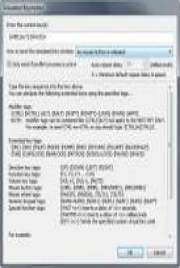
Free Mouse Customization Tools Many people don’t realize that their computer mouse can do much more than point and click. The free X-Mouse Button Management Tool (XMBC) allows you to unleash the full potential of the mouse by showing new functions on its buttons. Does XMBC allow you to reconfigure and expand the functions of the X-Mouse control button? X-Mouse Button Control is a safe and virus-free program available on Windows computers. It is compatible with Windows 10 and there are versions available for older operating systems. It was originally designed to run on x64-based versions of Windows, but it is also fully compatible with 32-bit versions. The required version (x64 or x86) is automatically determined in the section (function () {(‘review-app-page-desktop’);}); The program also supports various functions of various Windows operating systems, such as Flip3D in Vista, ModernUI / Metro in Windows 8, and virtual desktops in Windows 10. XMBC is not available for Mac. Alternatives to X-Mouse button control include a toggle switch. mouse speed, a remote mouse and AutoHotKey. There is also a portable version of XMBC called the X-Mouse Button Control Portable. X-Mouse Button Control is easy to download. Just run the exe installation and then follow the instructions on the screen, including approval of the license agreement. XMBC is available in a variety of languages other than English through community-translated language packs. To open XMBC, go to the system tray and double-click the corresponding icon. Right-click the icon to open additional options, including exiting the tool. How to change the mouse buttons? XMBC can be used to redisplay mouse buttons. This allows you to change the behavior of the mouse and scroll wheel buttons and assign a new task to each. However, the software is not just for button matching. It also allows you to make various navigation adjustments, including adjusting the pointer and scroll wheel to suit your needs. XMBC can also make changes to context. This means that the function of one button in one software may differ from the function of another. This is useful in many scenarios, including changing the behavior of the mouse in some windows, such as when the mouse wheel changes volume when scrolling over a system tray or YouTube video. Or you can play specific games that are not supported by the fourth and fifth mouse buttons. You can assign the corresponding keyboard shortcuts to each of these mouse buttons. The behavior of the program and the window is programmed by creating profiles that control the behavior of the mouse when switching between individual programs or windows. By default, profiles are activated automatically when the mouse is moved over a specific window or program. In each profile, you can configure up to 10 “layers” with different button settings, which you can toggle between using keyboard shortcuts or mouse buttons. How to use the X-Mouse button control? At first, using the X-Mouse control button can be a bit overwhelming – there are many options and the interface,although clean and clear, it does not guide you through the assignment process. Confused users may want to search the Internet for a user guide or tutorial, especially at first. However, it lacks simplicity, it is versatility. The software has an exhaustive list of functions that are available to display on the mouse buttons. These include toggle / combine buttons to perform various actions; create timed button actions that change depending on how long you hold the button; Match simulated keystrokes that send your own keystrokes, key sequences, or mouse actions when you click a mouse button. and run certain Windows programs. In total, there are around 100 different actions to choose from. When you open the X-Mouse button control, you will see a main window containing a list of program / window profiles. This list contains all the profiles that you have created and assigned to various programs or windows. From here, you can quickly add, enable, or disable profiles. If the profile text is red, it is an active profile. The corresponding profile information field shows how XMBC classifies the selected process or window. The information is the same as when creating a profile. The folder command list shows the tasks assigned to each of the nine possible mouse controls. Actions for each button are selected from the drop-down boxes. It is important to remember that the list of commands can be changed for each version of XMBC and that some objects are only available on certain operating systems. For example, only operating systems after Windows XP support standard skew messages. When you assign a mouse click (pressing a specific mouse button triggers a set keyboard command), there are nine methods to which you can send the assigned keystroke. These include sending keys when the mouse button is pressed or released, sending keys while holding down the mouse button, or continuously sending keys while holding down the mouse button. All these features add a fairly comprehensive program that can meet the needs of mouse configuration even for the most advanced users. Getting the mouse exactly the way you want it may take some time, but the effort will be worth it, but it’s still difficult to configure the mouse. X-Mouse Button Control is a powerful tool for configuring the mouse. It is ideal for people who want to perform a wide range of different functions at the touch of a button or by scrolling the scroll wheel. With approximately 100 different actions and available for nine mouse controls, the settings are almost endless. Due to this wide range of options, controlling the buttons on the X-Mouse can seem quite challenging and difficult for inexperienced users. Because no tool user guides are easily accessible, most users need time to fully understand what they can do;

發表評論